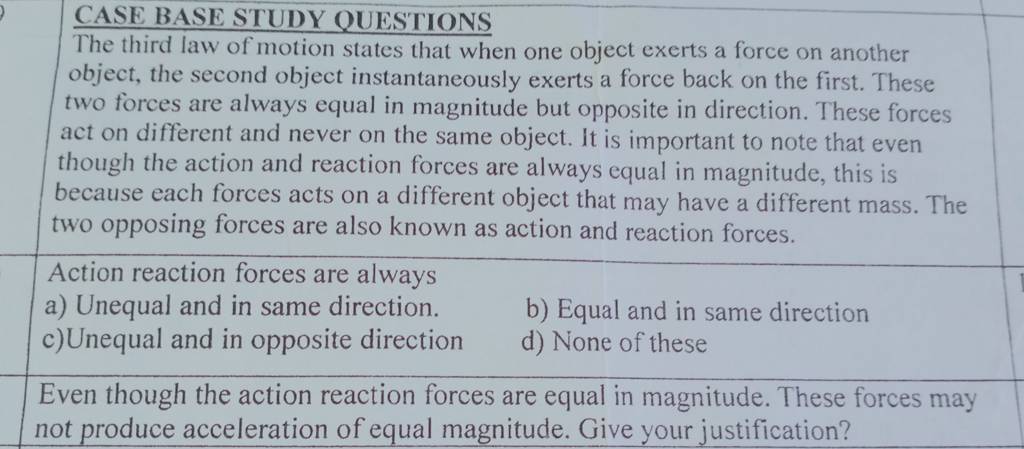Question
Question asked by Filo student

CASE BASE STUDY QUESTIONS The third law of motion states that when one object exerts a force on another object, the second object instantaneously exerts a force back on the first. These two forces are always equal in magnitude but opposite in direction. These forces act on different and never on the same object. It is important to note that even though the action and reaction forces are always equal in magnitude, this is because each forces acts on a different object that may have a different mass. The two opposing forces are also known as action and reaction forces. Action reaction forces are always
- Unequal and in same direction.
- Equal and in same direction
- Unequal and in opposite direction
- None of these
Found 5 tutors discussing this question
Discuss this question LIVE
5 mins ago

One destination to cover all your homework and assignment needs
Learn Practice Revision Succeed

Instant 1:1 help, 24x7
60, 000+ Expert tutors

Textbook solutions
Big idea maths, McGraw-Hill Education etc

Essay review
Get expert feedback on your essay

Schedule classes
High dosage tutoring from Dedicated 3 experts
Practice more questions on Physics
Question 1
Views: 5,633
Question 3
Medium
Views: 5,417
Students who ask this question also asked
Question 1
Views: 5,841
Question 2
Views: 5,604
Question 3
Views: 5,754
Question 4
Views: 5,312


Stuck on the question or explanation?
Connect with our Science tutors online and get step by step solution of this question.
231 students are taking LIVE classes
| Question Text | CASE BASE STUDY QUESTIONS The third law of motion states that when one object exerts a force on another object, the second object instantaneously exerts a force back on the first. These two forces are always equal in magnitude but opposite in direction. These forces act on different and never on the same object. It is important to note that even though the action and reaction forces are always equal in magnitude, this is because each forces acts on a different object that may have a different mass. The two opposing forces are also known as action and reaction forces. Action reaction forces are always |
| Updated On | Oct 7, 2022 |
| Topic | Physics |
| Subject | Science |
| Class | Class 9 |
| Answer Type | Video solution: 1 |
| Upvotes | 140 |
| Avg. Video Duration | 4 min |



